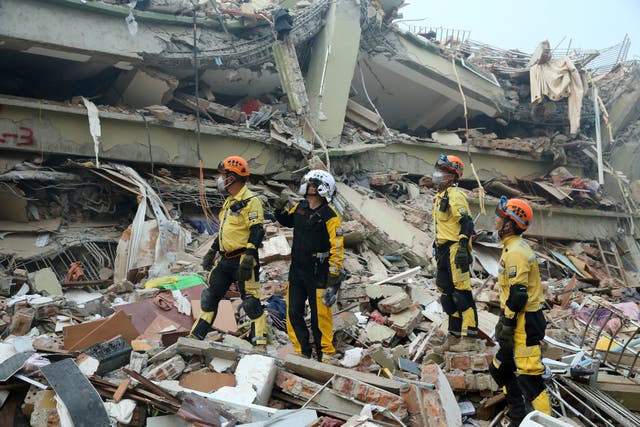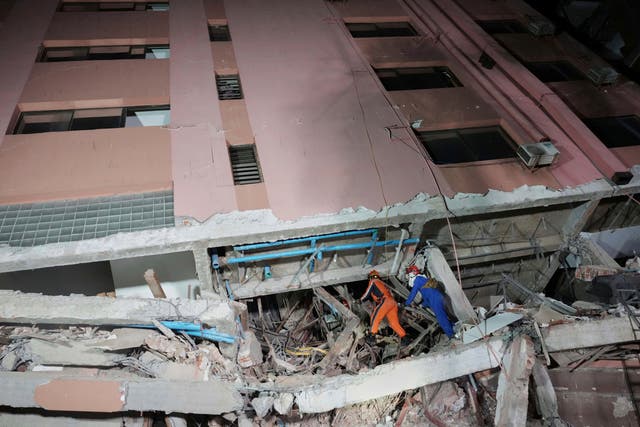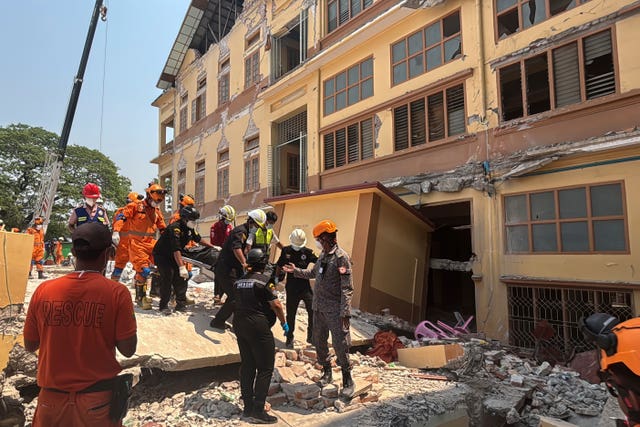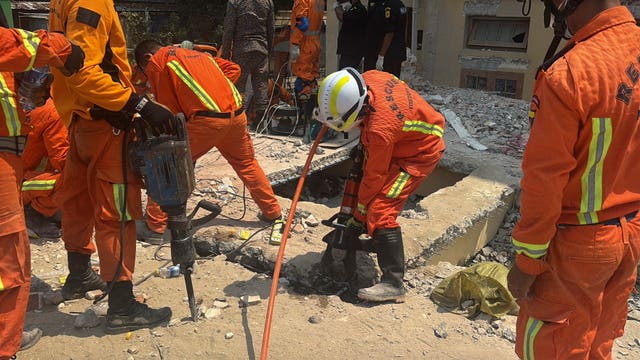Earthquake death tolls passes 1,700 in Myanmar
A Government spokesman said another 3,400 people have been injured and more than 300 were missing.

A massive earthquake that rocked Myanmar could exacerbate hunger and disease outbreaks in a country already wracked by food shortages, mass displacement and civil war, aid groups and the United Nations have warned.
The official death toll climbed past 1,700, but the true figure is feared to be much higher.
The 7.7 magnitude earthquake hit on Friday, with an epicentre near Myanmar’s second-largest city of Mandalay damaging the city’s airport, buckling roads and downing hundreds of buildings along a wide swathe of territory down the middle of the country.

Some 270 monks were taking an exam in Mandalay’s U Hla Thein monastery, which crumpled to the ground when the quake struck.
Seventy were able to escape, but rescue workers at the scene on Monday said 50 were found dead and that they were still searching for 150 more in the rubble.
Some 700 Muslim worshippers attending Friday prayers during the holy month of Ramadan were also killed when mosques collapsed, said Tun Kyi, a member of the steering committee of the Spring Revolution Myanmar Muslim Network.
It was not clear whether they or the monks were already included in the official count.
Mr Tun Kyi said some 60 mosques were damaged or destroyed, and videos posted on The Irrawaddy online news site showed several mosques toppling during the quake, and people fleeing from the areas.
With an ongoing civil war and poor infrastructure, Myanmar was already one of the most challenging places in the world for aid organisations to operate, and relief efforts have been further hampered by severe damage to roads, bridges and hospitals, power outages, fuel shortages and spotty communications.
A lack of heavy machinery has slowed search-and-rescue operations, forcing many to search for survivors by hand, with daily temperatures above 40 degrees Celsius (104 Fahrenheit).
Government spokesman Major General Zaw Min Tun told state-run MRTV that more than 1,700 people had been found dead and that another 3,400 have been injured and more than 300 were missing.
“This latest tragedy compounds an already dire crisis and risks further eroding the resilience of communities already battered by conflict, displacement, and past disasters,” the United Nations’ Myanmar country team said on Monday, calling for unimpeded access for aid convoys, medical personnel and assessment teams.

“Even before this earthquake, nearly 20 million people in Myanmar were in need of humanitarian assistance,” said Marcoluigi Corsi, the UN resident and humanitarian coordinator for Myanmar.
Aid agencies in Myanmar say their teams on the ground still do not have a true picture of the devastation.
“We’re really not clear on the scale of the destruction at this stage,” Lauren Ellery, deputy director of programs in Myanmar for the International Rescue Committee, told The Associated Press.
“They were talking about a town near Mandalay where 80% of the buildings were reportedly collapsed, but it wasn’t in the news because telecommunications have been slow.”
And groups the IRC works with reported that some places have been physically cut off by landslides, she said.
The World Health Organisation said it has reports of three hospitals destroyed and 22 partially damaged in the region.
“The scale of deaths and injuries is not yet fully understood and the numbers are expected to increase,” the UN agency said in a report.
“The earthquake’s devastation has overwhelmed health care facilities in the affected areas, which are struggling to manage the influx of injured individuals,” it added.
“There is an urgent need for trauma and surgical care, blood transfusion supplies, anesthetics, essential medicines, and mental health support.”

An artificial intelligence analysis of satellite images of Mandalay by Microsoft’s AI for Good Lab showed 515 buildings with 80%-100% damage and another 1,524 with between 20% and 80% damage.
It was not clear what percentage of the city’s buildings that represented.
Beyond the earthquake damage, rescue efforts are complicated by the bloody civil war roiling much of the country.
In 2021, the military seized power from the elected government of Aung San Suu Kyi, sparking what has since turned into significant armed resistance.
While one group in the civil war declared a partial unilateral ceasefire, the government and other armed groups have not stopped fighting, despite international calls to end the violence to facilitate the humanitarian response.
Government forces have lost control of much of Myanmar, and many places were dangerous or impossible for aid groups to reach even before the quake.
More than three million people have been displaced by the fighting, according to the UN.
Ms Ellery, of the International Rescue Committee, noted that the area worst hit by the earthquake was already seriously damaged by flooding last year in which many lost homes, and is also where many of the country’s internally displaced people have sought refuge.
Since the earthquake, many people have been sleeping outside, either because their homes have been destroyed or they are worried that the continuing aftershocks might bring them down.

With the monsoon rains starting in May, finding people shelter was going to be a major challenge, she said.
“You have these flooding events… that lead to disease outbreaks, they lead to displacement and food insecurity, but then with damaged hospitals and clearly damaged sanitation systems, it’s really increasing the risk of disease outbreaks,” she said.
”It’s pretty much unparalleled stress on many, many vulnerable people.”
International rescue teams from several countries are now on the scene, including from Russia, China, India and several south-east Asian countries.
On Monday, an Indian team jackhammered through slabs of fallen concrete at one site in Mandalay, cutting rebar reinforcement with an angle grinder powered by a portable generator as they sought to reach lower levels.
They could be seen bringing out one covered body and loading it into an ambulance.
The European Union, the UK, Australia, New Zealand, South Korea and others have announced millions of dollars in aid, either directly or through local partners and international organisations.
Despite massive cuts and firings at the US Agency for International Development — the body charged with delivering humanitarian assistance overseas — the American Embassy said a team of experts was on its way to Myanmar.
The embassy said it would provide up to two million dollars through local organisations.
A small number of American military personnel were also sent to assist in Bangkok, where the earthquake killed at least 19 people, many at a construction site where a partially built high-rise collapsed.
Another 33 have been reported injured and 78 missing, primarily at the construction site near the popular Chatuchak market.
On Monday, heavy equipment was temporarily shut down at the site and authorities urged onlookers to be silent as they used machines to try and detect any signs of life from under the rubble.
Bangkok governor Chadchart Sittipunt told reporters at the scene that signs had been detected Sunday night, though experts could not determine whether it had been machine error.
Watching the crews work in the rubble, Naruemon Thonglek said she had already “made some peace” with the fact that her partner and five friends believed buried beneath were unlikely to be found alive.
“A part of me still hope they will survive,” she said. “For a miracle, if it exists.”





